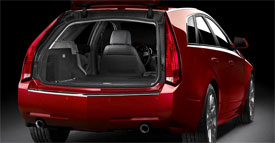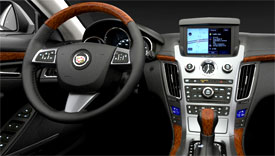2010 Cadillac CTS Sport Wagon
For almost a decade, Cadillac has been on a mission to change its image from mature-posh to Euro-chic. Their main weapon has been the mid-size CTS sedan. Well, with the CTS now firmly rooted as the best sport sedan ever made by an American brand, it’s time for Cadillac to do what a European brand would do, and build on success. This is the CTS Sportwagon-and it’s not just a way to get groceries fast!
The second generation Cadillac CTS bowed for 2008 with classic European sport sedan proportions and the most pleasing rendition yet of Cadillac’s angular “Art & Science” design language. That language is now extended to the 2010 CTS Sport Wagon. Riding on the same 113.4-inch wheelbase, the 5-door is in fact a third of an inch shorter overall than the 4-door at 191.3 inches.
The CTS’ big, confident grille, headlights, and tasteful fender ports carry over unchanged from the sedan. But the Wagon’s chrome-rimmed greenhouse gives its flanks a sporty, going-fast-standing-still character that is distinct from the sedan’s, jetting rearward into a substantial D-pillar. Angular vertical taillights rise above a near flush rear bumper, looking remarkably like fins. The CTS Sport Wagon grabs the pavement with low-profile rubber wrapped around 17-, 18-, or our car’s 19-inch alloy wheels.
 Like the sedan, the wagon’s interior is refined, sporty, and luxurious. The CTS has the richest interior design yet from GM. The big, serious motorcycle-style gauges remain, as does the tilt/telescoping wheel. Sophisticated center stack controls continue to fall pleasantly to hand. OnStar is standard, while optional is an 8-inch nav system with 3D imaging that rises out of the center dash. Also rising to the top is the available panoramic sunroof.
Like the sedan, the wagon’s interior is refined, sporty, and luxurious. The CTS has the richest interior design yet from GM. The big, serious motorcycle-style gauges remain, as does the tilt/telescoping wheel. Sophisticated center stack controls continue to fall pleasantly to hand. OnStar is standard, while optional is an 8-inch nav system with 3D imaging that rises out of the center dash. Also rising to the top is the available panoramic sunroof.
While BMW-like leatherette upholstery is standard, our car sported leather-trimmed buckets with French stitching. But their thin design also made them rigid and hard. Meanwhile, true to the European sport sedan and wagon formulas, rear seat legroom is tight.
But raise the standard power hatch and you’ll find a long, flat cargo floor complete with adjustable tie-down clips on rails. Pull up the floor panel and there’s hidden storage underneath. Cargo space measures 25 cubic feet seats up, with a center pass-through for long, skinny items. Folding the 60/40 rear seats yield a cavernous 53.4 cubic feet. That’s almost four times the CTS sedan’s trunk space.
A new all-aluminum 3.0-liter, 270-horsepower direct-injected V6 replaces the CTS’ previous base 3.6-liter port-fuel-injected V6. The new engine has both more power and higher fuel economy. Optional is our car’s direct-injected 3.6-liter V6, with the same stout 304 horsepower and 273 pound-feet of torque as the sedan.
Government fuel economy ratings for the rear drive 3.6-liter Sport Wagon are 18 city, 26 highway on regular gas, but all we managed was a rather disappointing 19.2 miles per gallon in mixed driving. The CTS’ Energy Impact Score of 16.3 barrels of oil a year and 8.7-ton Carbon Footprint match the Audi A6 Avant’s scores exactly.
A six-speed automatic with available paddle shifters is the Sport Wagon’s sole transmission. All-wheel-drive is also an option on the wagon, but ours invested all of its powers in the rear wheels with a limited-slip differential.
At the track, the Sport Wagon jogged to 60 in 7.2 seconds and through the quarter mile in 15.5 seconds at 93 miles per hour. Slow, deliberate shifts softened power delivery.
 Vented disc brakes with ABS and Brake Assist reside at each corner. They ground out average stops of 112 feet from 60 to 0, which is outstanding. Braking is a much sportier experience than acceleration, with fine stability, but more-than-expected nose dive.
Vented disc brakes with ABS and Brake Assist reside at each corner. They ground out average stops of 112 feet from 60 to 0, which is outstanding. Braking is a much sportier experience than acceleration, with fine stability, but more-than-expected nose dive.
Handling prowess depends on your choice of three suspension setups. The softest is designated FE1, which delivers a more traditional Cadillac ride. FE2 is significantly sportier, while the aggressive FE3 with load leveling is the stiffest. It transmits every road ripple back to the driver, but also delivers ultra-sharp handing that rivals Europe’s best.
Pricing for the CTS Sport Wagon starts at $40,655. All-wheel drive adds $1,900 more. Add the bigger engine, Nav, and sunroof and you’re well over 50 grand.
The 2010 Cadillac CTS Sport Wagon offers great style and serious versatility, yet retains all the athletic prowess of the CTS Sedan. That’s an impressive resume for any car of any shape, and it’s another step towards Cadillac emulating the best luxury sport brands from Europe. While many enthusiasts will resist any sporty car with a square back, the CTS Sport Wagon really is having your sport sedan and room for a wedding cake too.
Specifications
- Engine: Direct-injected 3.6-Liter V6
- Horsepower: 304
- Torque: 273 Lb Feet
- 0-60 MPH: 7.2 Seconds
- 1/4 Mile: 15.5 Seconds @ 93 MPH
- 60-0 MPH: 112 Feet
- EPA: 18 MPG City/ 26 MPG Highway
- Mixed Loop: 19.2 MPG
- Energy Impact: 16.3 Barrels Oil/Yr
- CO2 Emissions: 8.7 Tons/Yr
2024 Polestar 2
More Range And More Power For The Polestar 2
Volvo is well on their way to making the transition to an all-electric brand, but their sister-brand Polestar is already there. Now, we’ve spent lots of time in their all-wheel drive, five-door Polestar 2, having tested it in 2021, and a year later when a two-wheel drive version arrived. But, EV updates are coming quickly. So, let us be your guide for all that’s new with the Polestar 2.
While we are driving more EVs than ever, we’ve also been spending a lot of time recently circling back to ones we’ve previously tested. As in this new era of electrified vehicles, significant updates are arriving quickly, with R&D investments increasing and retrofitting them easier than ever. This is often done through software updates that can even be accomplished over the air. For 2024, the Polestar 2 has indeed gotten some software updates, but some physical ones as well.
Clearly aimed directly at Tesla’s Model 3 when it arrived; the Polestar 2’s build quality was vastly better, but range definitely came up short. So, addressing that was priority No. 1; and for ’24 the Polestar can travel up to 20% farther than before while consuming 9% less energy, and when it comes time to charge it back up, it can do that 34% faster too.
Range in the Single Motor version increases from a max of 270 to 320 miles thanks to a larger 82-kWh battery pack, and that solitary motor now powers the rear wheels, not the front wheels. It’s also bigger, coming in at 220 kW compared to the previous 170 kW front-wheel drive version, going from 231 to 299 horsepower.
Dual Motors keep the same 78-kWh battery, but still sees a boost from 260 to 276 miles and takes advantage of the larger rear motor for a new combined 310-kW output with 421 horsepower. Our test car has the added Performance Pack, which uses an additional 35 kW to deliver 455 horsepower and 546 lb-ft of torque, though max range drops to just 247 miles.
The new battery in rear-drive 2s will also charge faster, now accepting up to 205 kW for an 80% charge in 20 minutes; max for dual-motors stays at 155 kW, which puts an 80% charge at 34 minutes. Using 32 kWh of electricity per 100 miles, the Dual Motor earns a good efficiency rating.
The [Polestar] 2 has always been one of the most enjoyable EVs to drive, even more so now with that additional power coming from the rear motor.
Unfortunately, extremely cold temperatures kept us from seeing that increased range, as we were only on pace for about 194 miles in our test.
The 2 has always been one of the most enjoyable EVs to drive, even more so now with that additional power coming from the rear motor. And especially when equipped with the Performance Pack as it not only includes more power, but adds 20-inch forged wheels, upgraded brakes, and adjustable Ohlins Dual Flow Valve performance dampers. It greatly improves handling prowess without affecting ride quality, and is easily worth the $5,500 charge if you at all enjoy driving.
Even on a 20-degree track day there was plenty of grip through our handling course. No understeer or oversteer, and lots of feedback through the wheel. There was a nice, strong launch off the line that properly planted us firmly in the seat, and rocketed us to 60 in 4.5 seconds. Power delivery stayed pretty intense up until about 80 mph when there was a definite tapering off. Still, it was a 13.4-second quarter-mile at 102 mph; smooth, quiet, and stable the whole way.
When this car debuted, its Google-based infotainment setup was a novelty, but since then, more and more manufacturers are just “Googling it” so it doesn’t seem out of place at all. The wireless phone charger is easy to access, and there’s a great Harmon/Kardon sound system and panoramic sunroof to enhance the in-cabin experience. Exteriors have also been enhanced with a smooth grille insert and new wheel choices.
Hatchback practicality means 14.3 cu-ft of easy to access cargo space with split-folding seatbacks for longer items and expanding the space to 38.7 cu-ft. Plus, there’s even a sizeable storage bin up front under the hood.
Single Motor Polestar 2 pricing now starts at $51,300, with Dual Motors starting at $56,700; topping out at $64,400.
For a car manufacturer that hasn’t even been around for a decade yet, Polestar has kept itself busy, totally transforming their latest model in just a few years, making the 2024 Polestar 2 even more appealing. They are certainly off to a good start, and with a host of Polestars just over the horizon, including some all-important utility vehicles, this star will be shining even brighter.
Specifications
As Tested
- Motor Setup: Dual Motor
- Horsepower: 455
- 0-60 mph: 4.5 seconds
- EPA Range: 247 miles
- Efficiency : 32 kWh / 100 miles
- Battery Size: 78-kWh
- Torque: 546 lb-ft
- 1/4 Mile: 13.4 seconds at 102 mph
- MW Test Loop: ~ 194 miles
- Peak Charging Rate: 155 kW











































